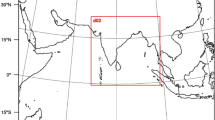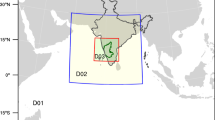Abstract
The impact of observations in a data assimilation (DA) may depend on various factors, and one aspect that can affect the impact is the specification of the background error covariance matrix. The present study compares the impact of INSAT-3D atmospheric motion vector (AMV) observations in traditional three-dimensional variational (3DVAR) DA system and hybrid ensemble transform Kalman filter (ETKF)-3DVAR DA system (HYBRID) available in Weather Research and Forecast (WRF) modeling system. The objective of the study is to understand how the impact of INSAT-3D AMV observations differ when assimilated using 3DVAR and HYBRID DA systems. The DA experiments are conducted over a ~4-week period of Indian summer monsoon rainfall of July 2016. Four sets of experiments are performed with and without INSAT-3D AMV in both the DA systems. The domain-wide verification with respect to radiosonde observations reveals that forecasts in HYBRID experiments are more accurate than 3DVAR experiments, in general. Geographical distribution depicts the positive impacts of INSAT-3D AMV observations across the domain in both 3DVAR and HYBRID DA systems. The AMV observations show a larger relative impact in HYBRID than in 3DVAR. The relative improvement in HYBRID with AMV DA compared to 3DVAR is 77% and 71% for wind and tropical temperature. The skill scores for quantitative evaluation of precipitation forecast indicate a modest improvement in rainfall for HYBRID run, and incorporating the AMV observation does not considerably enhance the skill of 24-h and 48-h rainfall forecast.










Similar content being viewed by others
Data availability
The NCEP global forecast system analyses and forecasts data that is utilized in this study are openly available in the repository https://rda.ucar.edu at https://doi.org/10.5065/D65Q4TSG. Data assimilation is performed using observations derived from NCEP ADP Global Upper Air and Surface Weather Observations archived in the https://rda.ucar.edu at https://doi.org/10.5065/Z83F-N512 and INSAT-3D satellite-derived atmospheric motion vectors from https://www.mosdac.gov.in.
Code availability
The atmospheric model used in this study is Weather Research and Forecast (ARW-WRF) of version 3.8.1, which is openly available for download in https://www2.mmm.ucar.edu/wrf/users/download/get_sources.html. The data assimilation package comes from WRFDA system of 3.8.1 version archived in https://www2.mmm.ucar.edu/wrf/users/download/get_sources.html#WRFDA.
References
Bouttier F, Kelly G (2001) Observing-system experiments in the ECMWF 4D-Var data assimilation system. Q J R Meteorol Soc 127:1469–1488
Courtier P et al (1998) The ECMWF implementation of three-dimensional variational assimilation (3D-Var). I: formulation. Q J R Meteorol Soc 124:1783–1807
Daley R (1991) Atmospheric data analysis, vol 2. Cambridge University Press. https://doi.org/10.1002/joc.3370120708
Deb S, Kishtawal C, Kumar P, Kumar AK, Pal P, Kaushik N, Sangar G (2016) atmospheric motion vectors from INSAT-3D: initial quality assessment and its impact on track forecast of cyclonic storm NANAUK. Atmos Res 169:1–16
Findlater J (1978) Observational aspects of the low-level cross-equatorial jet stream of the western Indian Ocean. Pure Appl Geophys 115:1251–1262. https://doi.org/10.1007/BF00874408
Gogoi RB, Kutty G, Rakesh V, Borogain A (2020) Comparison of the performance of hybrid ETKF-3DVAR and 3DVAR data assimilation systems on short-range forecasts during Indian summer monsoon season in a limited-area model. Pure Appl Geophys 177:5007–5026. https://doi.org/10.1007/s00024-020-02537-6
Hamill TM, Juras J (2006) Measuring forecast skill: Is it real skill or is it the varying climatology? Q J R Meteorol Soc 132:2905–2923
Hamill TM, Snyder C (2000) A hybrid ensemble Kalman filter–3D variational analysis scheme. Mon Weather Rev 128:2905–2919
Houtekamer PL, Mitchell HL, Pellerin G, Buehner M, Charron M, Spacek L, Hansen B (2005) Atmospheric data assimilation with an ensemble Kalman filter: results with real observations. Mon Weather Rev 133:604–620
Kalnay E (2003) Atmospheric modeling, data assimilation, and predictability. Cambridge University Press. https://doi.org/10.1017/CBO9780511802270
Kaur I, Kumar P, Deb S, Kishtawal C, Pal P, Kumar R (2015) Impact of Kalpana-1 retrieved atmospheric motion vectors on mesoscale model forecast during summer monsoon 2011. Theor Appl Climatol 120:587–599
Kumar P, Deb SK, Kishtawal C, Pal PJT (2017) Impact of assimilation of INSAT-3D retrieved atmospheric motion vectors on short-range forecast of summer monsoon 2014 over the south Asian region. Theor Appl Climatol 128:575–586
Kutty G, Wang X (2015) A comparison of the impacts of radiosonde and AMSU radiance observations in GSI based 3DEnsVar and 3DVar data assimilation systems for NCEP GFS. Adv Meteorol 2015:1–17. https://doi.org/10.1155/2015/280546
Kutty G, Muraleedharan R, Kesarkar AP (2018) Impact of representing model error in a hybrid ensemble-variational data assimilation system for track forecast of tropical cyclones over the Bay of Bengal. Pure Appl Geophys 175:1155–1167
Leslie L, LeMarshall J, Morison R, Spinoso C, Purser R, Pescod N, Seecamp R (1998) Improved hurricane track forecasting from the continuous assimilation of high quality satellite wind data. Mon Weather Rev 126:1248–1258
Lorenc A (2003) The potential of the ensemble Kalman filter for NWP—a comparison with 4D-Var. Q J R Meteorol Soc 129:3183–3203
Mounika K, Kutty G, Gorthi SSR (2018) Consistent robust and recursive estimation of atmospheric motion vectors from satellite images. IEEE Trans Geosci Remote Sens 57:1538–1544
Pai D, Sridhar L, Rajeevan M, Sreejith O, Satbhai N, Mukhopadhyay B (2014) Development of a new high spatial resolution (0.25× 0.25) long period (1901–2010) daily gridded rainfall data set over India and its comparison with existing data sets over the region. Mausam 65:1–18
Parrish DF, Derber JC (1992) The National Meteorological Center’s spectral statistical-interpolation analysis system. Mon Weather Rev 120:1747–1763
Prasad V, Johny C, Sodhi JS (2016) Impact of 3D Var GSI-ENKF hybrid data assimilation system. J Earth Syst Sci 125:1509–1521
Rani SI, Gupta D (2014) An inter-comparison of K alpana-1 and M eteosat-7 atmospheric motion vectors against radiosonde winds and NWP forecasts during monsoon 2011. Meteorol Appl 21:820–830
Sankhala DK, Deb SK, Sathiyamoorthy V (2019) INSAT-3D low-level atmospheric motion vectors: capability to capture Indian summer monsoon intra-seasonal variability. J Earth Syst Sci 128:31
Sankhala DK, Deb SK, Sharma SK, Lal S (2020) Inter-comparison of INSAT-3D atmospheric motion vectors height with cloud-base height from a Ceilometer. Int J Remote Sens 41:2946–2961
Sawada M, Ma Z, Mehra A, Tallapragada V, Oyama R, Shimoji K (2019) Impacts of assimilating high-resolution atmospheric motion vectors derived from Himawari-8 on tropical cyclone forecast in HWRF. Mon Weather Rev 147:3721–3740
Skamarock WC, Klemp JB, Dudhia J, Gill DO, Barker D, Duda MG et al (2008) A description of the advanced research WRF version 3 (No. NCAR/TN-475+STR). University Corporation for Atmospheric Research. https://doi.org/10.5065/D68S4MVH
Soden BJ, Velden CS, Tuleya RE (2001) The impact of satellite winds on experimental GFDL hurricane model forecasts. Mon Weather Rev 129:835–852
Velden CS, Hayden CM, Paul Menzel W, Franklin JL, Lynch JS (1992) The impact of satellite-derived winds on numerical hurricane track forecasting. Weather Forecast 7:107–118
Wang X, Snyder C, Hamill TM (2007) On the theoretical equivalence of differently proposed ensemble–3DVAR hybrid analysis schemes. Mon Weather Rev 135:222–227
Wang X, Barker DM, Snyder C, Hamill TM (2008) A hybrid ETKF–3DVAR data assimilation scheme for the WRF model. Part I: observing system simulation experiment. Mon Weather Rev 136(12):5116–5131
Wu W-S, Purser RJ, Parrish DF (2002) Three-dimensional variational analysis with spatially inhomogeneous covariances. Mon Weather Rev 130:2905–2916
Zhang S, Pu Z, Velden C (2018) Impact of enhanced atmospheric motion vectors on HWRF hurricane analyses and forecasts with different data assimilation configurations. Mon Weather Rev 146:1549–1569
Zhang M, Zhang F, Huang XY, Zhang X (2011) Intercomparison of an ensemble Kalman filter with three-and four-dimensional variational data assimilation methods in a limited-area model over the month of June 2003. Mon Weather Rev 139(2):566–572
Acknowledgements
The authors thankfully acknowledge the Indian Institute of Tropical Meteorology for providing us high performance computing resources.
Author information
Authors and Affiliations
Contributions
Rekha Bharali Gogoi performed the experiments and wrote the manuscript. G Kutty analyzed the results. G Kutty and Arup Boroghain supervised the research work.
Corresponding author
Ethics declarations
Competing interests
The authors declare no competing interests.
Additional information
Publisher’s note
Springer Nature remains neutral with regard to jurisdictional claims in published maps and institutional affiliations.
Rights and permissions
About this article
Cite this article
Gogoi, R.B., Kutty, G. & Boroghain, A. Intercomparison of the impact of INSAT-3D atmospheric motion vectors in 3DVAR and hybrid ensemble-3DVAR data assimilation systems during Indian summer monsoon. Theor Appl Climatol 145, 585–596 (2021). https://doi.org/10.1007/s00704-021-03649-2
Received:
Accepted:
Published:
Issue Date:
DOI: https://doi.org/10.1007/s00704-021-03649-2




